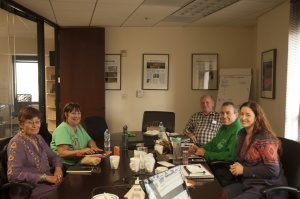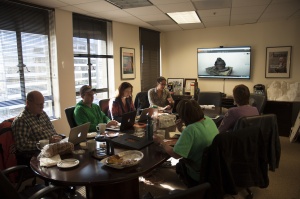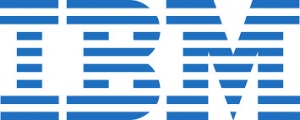IBM Brings New CyArk Lesson Plans to the Public!
CyArk and Local Teachers Develop Lesson Plans from CyArk's Rich Archive
March 24, 2015
Since 2012, IBM has supported the growth of CyArk’s educational reach, whether through integrating our existing lesson plans into IBM’s Teachers TryScience platform for wider dissemination, generating entirely new lesson plans through workshop intensives, or conducting school outreach to strengthen visibility. Last month, I was thrilled to host a workshop at CyArk’s office to introduce local teachers to our 3D heritage archive and collaborate on new lesson plans to further expand our educational content. Not only did this workshop provide an ideal environment to explore IBM’s Teachers TryScience website, a free resource for teachers designed to strengthen science, technology, engineering, art, and math (STEAM) education, but it also allowed for a new set of eyes to study CyArk’s archive of heritage sites for applications in the classroom.
This year, we were pleased to welcome five teaching professionals to contribute their vast academic and teaching experiences to our workshop: Mr. Paul Rendone, 3rd Grade Teacher at Bentley Lower School in Oakland; Mr. Robert Schug, History Teacher at Bentley Middle School in Oakland; Ms. Nancy Ely, 7th Grade History and Social Studies Teacher at Bay Farm Elementary in Alameda; Ms. Jeannette Frechou, 7th Grade Science and Math Teacher at Bay Farm Elementary in Alameda; and Ms. Jenn Scheller, High School Technical Theatre and Sculpture Teacher, and co-coach of the Remote Operated Vehicle (ROV) Program, at Bentley High School in Lafayette.
These wonderful teachers volunteered to spend a Saturday at our office to produce five entirely new K-12 lesson plans. With academic backgrounds in technology, science, history, visual arts, and project based learning, our collaborative workshop truly expanded CyArk’s geographic and cultural diversity represented in our online lesson plan database, engaging projects from around the globe and encouraging cross-disciplinary approaches to STEAM education.
These lesson plans utilize CyArk’s digital preservation projects to discuss a variety of academic subjects, including: researching the global impact of the trans-Atlantic slave trade; understanding urban and social development of the slave market town of Natchez, Mississippi; studying and reconstructing stepwells to understand construction materials, functionality, and ceremony; explaining the social function and construction techniques of historic and contemporary astrological observatories; and analyzing regional resources for the reconstruction of California Missions. Each lesson has immediate connections to specific heritage sites around the world, and also engages the students in a research and scientific study to analyze historic technological advances and the growth of the world as we know it today.
There is incredible value in utilizing cultural heritage to teach science, technology, engineering, art, and math (STEAM) topics, and CyArk is pleased that our content can inspire teachers and students to engage in interdisciplinary learning. On behalf of the CyArk family, I would like to give my sincere thanks to our participants from Bay Farm Elementary and Bentley School, and to IBM for supporting the growth of such an integral part of CyArk’s mission. Stay tuned in the coming weeks for these lesson plans to go live in both English and Spanish on CyArk’s and IBM’s Teachers TryScience websites!
This year, we were pleased to welcome five teaching professionals to contribute their vast academic and teaching experiences to our workshop: Mr. Paul Rendone, 3rd Grade Teacher at Bentley Lower School in Oakland; Mr. Robert Schug, History Teacher at Bentley Middle School in Oakland; Ms. Nancy Ely, 7th Grade History and Social Studies Teacher at Bay Farm Elementary in Alameda; Ms. Jeannette Frechou, 7th Grade Science and Math Teacher at Bay Farm Elementary in Alameda; and Ms. Jenn Scheller, High School Technical Theatre and Sculpture Teacher, and co-coach of the Remote Operated Vehicle (ROV) Program, at Bentley High School in Lafayette.
These wonderful teachers volunteered to spend a Saturday at our office to produce five entirely new K-12 lesson plans. With academic backgrounds in technology, science, history, visual arts, and project based learning, our collaborative workshop truly expanded CyArk’s geographic and cultural diversity represented in our online lesson plan database, engaging projects from around the globe and encouraging cross-disciplinary approaches to STEAM education.
These lesson plans utilize CyArk’s digital preservation projects to discuss a variety of academic subjects, including: researching the global impact of the trans-Atlantic slave trade; understanding urban and social development of the slave market town of Natchez, Mississippi; studying and reconstructing stepwells to understand construction materials, functionality, and ceremony; explaining the social function and construction techniques of historic and contemporary astrological observatories; and analyzing regional resources for the reconstruction of California Missions. Each lesson has immediate connections to specific heritage sites around the world, and also engages the students in a research and scientific study to analyze historic technological advances and the growth of the world as we know it today.
There is incredible value in utilizing cultural heritage to teach science, technology, engineering, art, and math (STEAM) topics, and CyArk is pleased that our content can inspire teachers and students to engage in interdisciplinary learning. On behalf of the CyArk family, I would like to give my sincere thanks to our participants from Bay Farm Elementary and Bentley School, and to IBM for supporting the growth of such an integral part of CyArk’s mission. Stay tuned in the coming weeks for these lesson plans to go live in both English and Spanish on CyArk’s and IBM’s Teachers TryScience websites!

Workshop participants joined us for a full day of reviewing CyArk's dense archive and developing new lesson plans for public dissemination.

This year's workshop engaged five local teachers from K-12 schools in Oakland, Alameda, and Lafayette.

IBM has generously supported CyArk's educational growth and outreach since 2012.